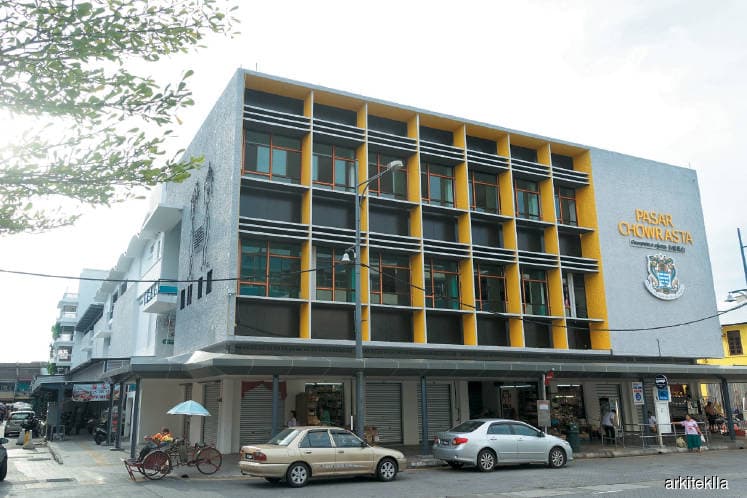
This article first appeared in City & Country, The Edge Malaysia Weekly on November 6, 2017 - November 12, 2017
Honorary Mention | Revitalisation of Chowrasta Market | Majlis Bandaraya Pulau Pinang
Chowrasta Market in central George Town is more than a historical building to be admired — it is full of life. People come here to buy their daily necessities and local titbits, especially pickled nutmeg. The market’s colourful history dates back to the mid-19th century when ethnic Tamils from southern India started their early settlements on Penang island. This explains the presence of Tamil Street near the marketplace, which is also bordered by Chowrasta Road, Kuala Kangsar Road and Penang Road.
From a 1-storey market built in 1890, Chowrasta Market was converted into a 2-storey building in 1961. It went through another major makeover between 2013 and recently. The market received an Honorary Mention in The Edge Malaysia-PAM Green Excellence Award 2017.
“We want to demonstrate that it is always possible for a building to stay sustainable in a very challenging environment through the conservation and reuse of existing structures and materials,” Penang Island City Council (MBPP) secretary Yew Tung Seang says in a telephone interview, referring to the showpiece designed by Arkitek LLA.
As the local authority in charge of Chowrasta Market, MBPP walked the talk by retrofitting the building, making it more sustainable with improved natural ventilation and internal spaces, alongside the recycling of concrete as hardcore infill, steel and other reusable metals such as the grillwork, which was either maintained or reused. The original vent blocks were carefully dismantled and incorporated into the façade.
“This is possibly the first Green Building Index (GBI) certified market in Malaysia. It will certainly set a new benchmark to inspire others. It is a collective effort by all stakeholders, including members of the community who took part in the focus group discussions,” Yew says.
There were 76 meetings, forums, discussions and exhibitions before and during the four-year redevelopment process, with people from all walks of life tackling issues of contested spaces and cultural sensitivity. The extensive community engagement involved MBPP, Badan Warisan Malaysia, architects, traders and the general public while the sustainable design took into consideration the social, cultural and historic landscape governing the evolving and intertwined surroundings.
“The reinvigorated Chowrasta Market is now a multi-use market with a business mix that allows for longer activity hours to fulfil the needs of today’s community. Tourists come here for local titbits and to experience the vibrant market,” Yew says, emphasising the equally important economic sustainability of the market.
The retrofitted market caters for traders, shoppers and the community, beyond daily necessities and other items, with amenities that include ATMs, a post office and local council payment counter.
“The redesign is in line with the local culture and context. Here, you can see the very essence of George Town’s living cultural heritage, where people go about their daily lives. It is a continuity of past glories,” Yew adds.
One of the biggest challenges in the regeneration of this urban market was carrying out the makeover without interrupting the daily market activities, not to mention the temporary relocation of the traders.
“The new design addressed the inadequacy of lighting, ventilation and visibility for traders. Spaces have been opened up and every floor is now more accessible than before. For better humidity control, we removed the internal partitions and external obstructions to allow more natural lighting and ventilation, especially for the wet market area,” Arkitek LLA director Ong Jin Cheng explains.
“The end product we see today is a living embodiment of sustainability in terms of structure, use and community,” he says, adding that moving from one zone to another is now more comfortable and appealing.
The ground floor is segmented into wet (for seafood), semi-wet (vegetables), semi-dry (poultry) and dry (dry goods, especially local specialities) zones. The first floor houses a food court and shops selling a variety of things such as clothing and second-hand books. A conjoined multi-storey car park with over 120 bays was built to address the parking shortage and encourage vehicular separation from the pedestrian flow.
Trees skirt the market while climbing plants drape the car park, providing more greenery. The market has a rainwater harvesting system for washing the floors, in addition to the on-site bio-waste treatment and disposal facility, a solution provided by Bio Regen Photonics Sdn Bhd. It also serves as a collection centre for surrounding food vendors and eateries under Penang’s food waste segregation programme.
According to Yew, about 2,200 tonnes of waste is generated in Penang each day, with up to 60% of it organic. “Having introduced the waste segregation programme from June 1, Penang aims to achieve a 40% recycling rate by 2020, against the 22% national level,” he says.
“We are happy with the building and we really hope that it does not need much upgrading in the next decade or so. What we need now is regular maintenance to ensure its efficient functioning.” Yew is optimistic, despite there being no easy answer to sustainable design.
Save by subscribing to us for your print and/or digital copy.
P/S: The Edge is also available on Apple's AppStore and Androids' Google Play.